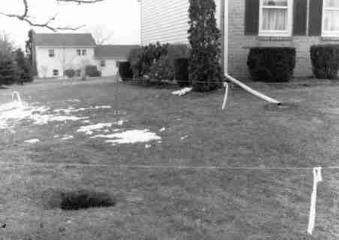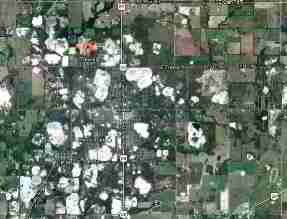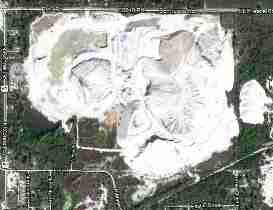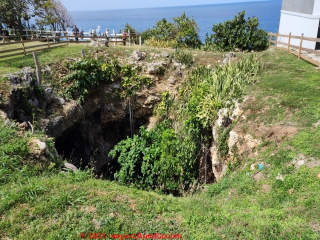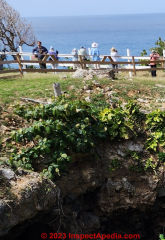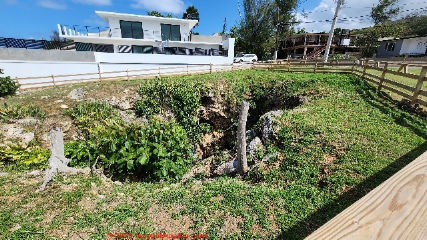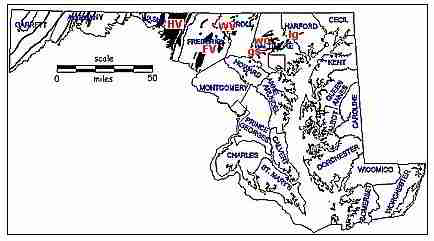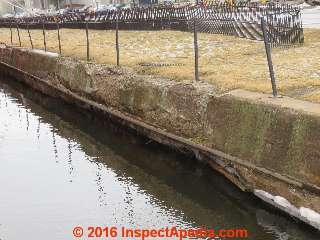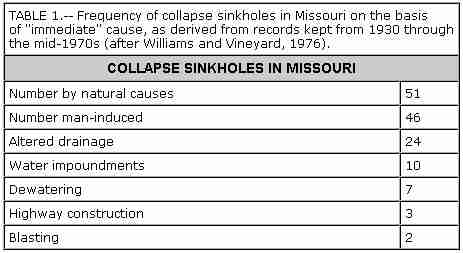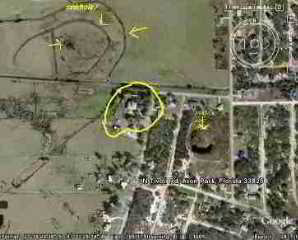 Sinkholes & Subsidences
Sinkholes & Subsidences
Home Page & Index to Key Articles
- POST a QUESTION or COMMENT about sinkholes and their effects on buildings
Sinkholes: what is a sinkhole & where do they occur?
We explain what sinkholes are and why they occur, describes their effects on buildings, and gives building and site inspection advice useful in identifying areas where there is an increased risk of sink holes at properties.
We explain how sinkholes can be spotted, sometimes before a sudden collapse, and what to do if you know or suspect that a sinkhole is developing on or close to your property.
This article series includes a photo catalog of significant sinkholes & soil subsidences around the world. Inspecting a property for signs of sink holes or landslides. Types of sink holes, signs of sink holes, landslides. Causes of sinkholes & some landslides. Sink hole or landslide damage and risks. When to hire a geotechnical engineer for sinkhole, landslide, unstable soils, or soil testing.
Catalog of types of sink holes around the world including California, Canada, Quebec, Estonia, Guatemala, Maryland, New York, Pennsylvania, Texas,Tennessee, Virginia and other states and provinces and countries. Explanation of causes of sinking buildings from events other than sinkholes.
InspectAPedia tolerates no conflicts of interest. We have no relationship with advertisers, products, or services discussed at this website.
What are Sinkholes, How Big Are Sinkholes, & Where do Sinkholes Occur?
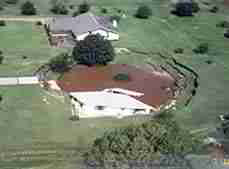
In general terms a sinkhole is any sudden subsidence of the earth. In more technical terms, a true "sinkhole" is a subsidence or soil collapse caused by a combination of water eroding supporting soils, rock, or limestone, and an underlying geological structure or material that is particularly vulnerable to dissolving in water.
But consistent with their cause and the underlying soil and geology, the actual cause, and the size and dangers of sinkholes vary widely, from a small subsidence over an abandoned septic tank or swimming pool, to enormous sinkholes that swallow towns.
Here we describe this variety of sinkholes and soil subsidences, their locations, causes, sizes, and impact or dangers.
Synonyms and similar terms for sink holes include: shake hole, swallow hole, swallet, doline, cenote, moulin, and glacier mill.
Urban or suburban sinkholes due to burst water mains, sewer lines, or storm drains can occur almost anywhere.
Here we focus on other sinkhole types and causes including sinkholes due to geological formations, types of rock (karst formations), or due to human activities such as mining. We also discuss here sinking buildings from causes other than sinkholes.
"Sinkholes" that are not verified by a licensed professional geologist or geotechnical engineer to be a true sinkhole are also described in various publications as subsidence incidents.
Readers should see SINKHOLES - IMMEDIATE SAFETY ACTIONS, and also
see FOUNDATION CRACKS & DAMAGE GUIDE
Additional septic system safety warnings are at SEPTIC & CESSPOOL SAFETY.
The bare minimum that a property owner needs to know about sinkholes or any other sudden subsidence of soils at a property is that these conditions might be very dangerous.
Someone falling into a sink hole or into a collapsing septic tank could be seriously injured or even die.
If a suspicious hole, subsidence, or depression appears at a property the owner should rope off and prevent access to the area to prevent anyone from falling into the opening, and then should seek prompt assistance from a qualified expert, geotechnical engineer, septic contractor, excavator, or the like.
The photograph (above-left) of a sinkhole opening in a residential yard in Pennsylvania is from Kochanov, W.E. and illustrates the child hazard or even adult sinkhole hazard that can be formed by storm water drainage.
Article Series Contents
- SINKHOLES & SUBSIDENCES - home
- DEFINITION of SINKHOLES
- GHOST LAKES
- SEAWALL SINKHOLES & SUBSIDENCES - separate article
- Sinkholes in ALABAMA
- ALASKA SINKING HOUSE REPORT
- ARCTIC SINKHOLES
- Sinkholes in BELIZE
- Sinkholes in Berezniki RUSSIA
- Sinkholes in BRITISH COLUMBIA
- Sinkholes in CALIFORNIA
- Sinkholes in CANADA
- Sinkholes in ENGLAND
- Sinkholes in ESTONIA
- SINKHOLES in FLORIDA
- SINKHOLES in GEORGIA
- Sinkholes in GUATEMALA
- Sinkholes in ICELAND
- Sinkholes in KANSAS
- Sinkholes in KENTUCKY
- Sinkholes in LITHUANIA
- SINKHOLES in MARYLAND
- Sinkholes in MEXICO
- SINKHOLES in MINNESOTA - includes subsidences at seawalls
- Sinkholes in MISSOURI
- SINKHOLES in NEW YORK
- Sinkholes in OHIO
- Sinkholes in OKLAHOMA
- SINKHOLES in PENNSYLVANIA
- Sinkholes in PORTUGAL
- SINKHOLES in PUERTO RICO
- SINKHOLES in QUEBEC, Leda Clay
- SINKHOLES in TENNESSEE
- Sinkholes in TEXAS
- SINKHOLES in VIRGINIA
- SINKHOLE RESEARCH & REFERENCES
- SINKHOLE DAMAGE REPAIRS
- SINKHOLE DETECTION, WARNING SIGNS
- SINKHOLES - IMMEDIATE SAFETY ACTIONS
- SINKHOLES COURSE - X-Ray Vision?
- SINKHOLES on KARST FORMATIONS
- SINKHOLES on LEDA CLAY FORMATIONS
- SINKING BUILDINGS
- SINKHOLE RESEARCH & REFERENCES
- SOIL PROPERTIES & BUILDING FAILURES
See "Developing your X-Ray Vision - A Promotion Theory for Forensic Observation of Residential Construction - Levels of Fear, and how to use them to find and report significant, hidden problems, discussed at this titl: ADVANCED INSPECTION METHODS
https://InspectAPedia.com/home_inspection/Building_Inspection_Techniques.php
Also see the FEAR-O-METER a promotion theory to convert risk of hidden defects & hazards into action thresholds, for a discussion of how an accumulation of inspection evidence leads to a rational decision to perform invasive or desctructive inspection measures.
Also see The Nature of Vision - Inspecting Complex Systems - When and Why Inspectors "See" or "Don't See" Things Which are Present - InspectApedia.com/vision/Visual_Perception_Errors.php. Comments and content suggestions are invited.
What are sinkholes and why do they occur?
A sinkhole is a subsidence feature. Subsidence is the downward movement of surface material; it involves little or no horizontal movement.
Subsidence occurs naturally due to the physical and chemical weathering of certain types of bedrock.
Subsidence can also occur as a result of underground mining, excessive pumping of groundwater, or subsurface erosion due to the failure of existing utility lines. All of these examples of subsidence can produce surface features that appear similar, but not all are naturally occurring.
Some are solely the result of human activities. - Kochanov, W.E.
Because the causes of sinkholes vary by geographic area, soil conditions, and human activity, we discuss the character, cause, signs, and repair of sinkholes in different areas of the U.S., Canada, and other countries in this article.
Links at the end of this article and at page bottom continue sinkhole discussion in more detail by geographic area, sink hole type, and other factors. Four types of karst sinkholes are described
Smaller Soil Subsidences Also Called "Sinkholes"
When an expert such as a geotechnical engineer uses the term "sinkhole" s/he refers to generally large soil subsidences that we described just above and caused by the events we just described. But in more popular speech among homeowners, attorneys, and contractors, smaller site subsidences may also be referred to as "sinkholes" and may be caused by events such as collapsing soils or smaller sized but still dangerous sinkholes over
- an abandoned buried oil storage tank
See details
at OIL TANK ABANDONING PROCEDURE - a septic tank, cesspool or drywell -
See important safety warnings
at CESSPOOL SAFETY WARNINGS - buried gasoline or other fuel storage tanks
- buried debris, garbage, trees, tree-stumps.
- dug wells
- areas of soil wash-out due to burst water mains or leaking water or sewer piping
Watch out: these smaller collapses are still potentially very dangerous, even fatal, should an adult or child fall into an opening, pit, or subsidence. [3][4]
How big are sinkholes? Most sinkholes are 10 to 12 feet in diameter. Sinkholes hundreds of feet in diameter have occurred in Eastern Canada, Florida, and Texas - big enough to swallow a home. The "December Giant" sinkhole in Montevallo, Alabama was 520 x 125' and 60' deep. The Dasietta Texas sinkhole reached 525' x 600' and a depth of 150', collapsing an era of roughly 1/10 of a square mile within two days of its first appearance. The September 1999 Lake Jackson sinkhole near Tallahassee Florida drained the lake into a 50-foot deep sinkhole.
See Ghost Lakes discussed below.
Sinkholes of enormous size and depth do occur in some locations, such as the 330 foot deep sinkhole in Guatemala City (2010), and the Rissa, Norway 1978 soil collapse covering more than 330,000 square meters.
Sinkhole repairs:
A discussion of foundation repair methods such as driven piers, helical piers, or other structural repair methods may seem in order, but if a sink hole is big enough to swallow a home, the first order of business for areas where those problem soils are found (California sinkholes, Florida sinkholes, Pennsylvania sinkholes over mines, Texas sinkholes, often over salt domes and possibly affected by wastewater disposal back into the ground during oil drilling, others) is to recognize the signs that sinkholes have plagued a neighborhood and/or that a sinkhole is presently developing at a particular home.
Sinkholes have been reported world-wide, including including California, Canada, Quebec, Estonia, Guatemala, Maryland, New York, Pennsylvania, Texas, Virginia.
Significant to property inspectors, the first signs that a sinkhole was developing in Dasietta Texas was the opening up of cracks in the ground and in the roadway on the morning of the collapse.
Because a sinkhole can develop suddenly and expand rapidly, the sudden appearance of cracks in the earth should be taken as a serious safety hazard at any location, more so in an area where sinkholes are known to occur.
What about cases where a sinkhole collapse may be ongoing or imminent? Recognizing indicators of potential sinkholes can reduce but not eliminate this risk. This limitation should be stated clearly by any home inspector in an area where sinkholes are known to occur or wherever one is suspected.
If a sinkhole is already visible near an inspected property or if signs of a sinkhole are observed this information should be cited by the inspector as a potential safety concern and significant expense requiring immediate professional action.
Sinkholes in Alabama
The Neversink TAG Pit, located in Jackson County, Alabama is a Karst formation or limestone-formation sink hole about 40 feet in diameter at its top and 100 wide at its bottom. feet deep. Details are
at WHAT IS KARST?.
Since 199t the Neversink pit has been owned and operated by the Southeastern Cave Conservancy and Karst Preserves. Contact SCCI.org.
Alabama Sinkhole Research
- Beck, B. F. (2003). Sinkholes and the Engineering and Environmental Impacts of Karst. Huntsville, Alabama: The American Society of Civil Engineers.
Hydraulic Fracturing Temblors in Arkansas
See Sinkholes & Temblors in OHIO
Arctic Sinkholes & Methane Gas Explosions
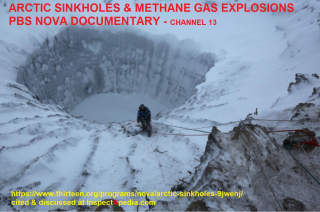 Scientists at the University of Alaska, Fairbanks, have been investigationg large sinkholes developing in the Arctic and accomopanying methane gas releases and explosions.
Scientists at the University of Alaska, Fairbanks, have been investigationg large sinkholes developing in the Arctic and accomopanying methane gas releases and explosions.
An apparent effect on the Arctic of global warming has been the release of large amounts of methane previously frozen or "locked" in the permafrost found in that area. These large releases of methane gas contribute to the greenhouse effect of adding methane gas to the atmosphere and thus increase the effects of global warming.
In February, 2022 in the U.S. a NOVA episode on Arctic Sinkholes aired and provided graphic illustration of recent Arctic sinkholes. NOVA episodes can be still be observed via access to PBS and by paid memberships in services such as Channel 13 or through other resources.
Arctic sinkhholes have been studied at least since the 1970s (Ford 1971) but were not linked to global-warming until more recently (Lulu 2005 et als).
- NOVA Season 49, Episode 1, Arctic Sinkholes, Preview, available at Channel 13 at https://www.thirteen.org/programs/nova/arctic-sinkholes-preview-lamink/
Excerpt: Colossal explosions shake a remote corner of the Siberian tundra, leaving behind massive craters. In Alaska, a huge lake erupts with bubbles of inflammable gas. Scientists are discovering that these mystifying phenomena add up to a ticking time bomb, as long-frozen permafrost melts and releases vast amounts of methane, a potent greenhouse gas. - NOVA Episode: Arctic Sinkholes, aired 2/2/2022 and expiring 2/1/2025, available through Channel 13 at: https://www.thirteen.org/programs/nova/arctic-sinkholes-9jwenj/
- Ford, Derek C. "Alpine Karst in the Mt. Castleguard-Columbia icefield area, Canadian rocky mountains." Arctic and Alpine Research 3, no. 3 (1971): 239-252.
Abstract:
Mt. Castleguard and an adjacent valley, Castleguard Meadows, are situated at the southeastern margin of the Columbia Icefield. The mountain and meadows are underlain by massive Middle Cambrian limestones with some shales and dolomite interbeds; the rocks dip gently southeast. They are well karstified and a close juxtaposition of karst, glacial, and periglacial erosion processes can be observed. Above 2,300 m karst features occur on surfaces recently abandoned by Neoglacial ice, and much meltwater evidently sinks underground beneath the extant glaciers.
Outside of Neoglacial margins limestone surfaces are reduced to felsenmeer devoid of karst features. In tundra below 2,300 m shaft-type sinkholes and many varieties of karren occur. Sinkholes are aligned along shale contacts and the distal edges of terminal moraines and are randomly distributed elsewhere.
Underground drainage developed in two phases. (1) Castleguard Cave drained part of the central Icefield area downdip to springs at 2,000 m. The cave is a single river passage, longer than 10 km and passing beneath Mt. Castleguard. It has vadose and phreatic erosional elements and is attributed to the last interglacial. (2) In late- or postglacial times, Castleguard Cave was abandoned and a new conduit developed beneath it. This discharges at the “Big Springs” at 1,740 m.
Drainage of the northern Meadows and Mt. Castleguard is incorporated into this second system. Discharge of the Big Springs is comparable in magnitude to that of the meltriver of Saskatchewan Glacier, the largest valley glacier draining the Icefield. The area illustrates that karst groundwater circulation may be maintained and even initiated at the soles of temperate glaciers. - Fortier, Daniel, Michel Allard, and Yuri Shur. "Observation of rapid drainage system development by thermal erosion of ice wedges on Bylot Island, Canadian Arctic Archipelago." Permafrost and Periglacial Processes 18, no. 3 (2007): 229-243.
Abstract:
Rapid development of a new drainage system was observed on Bylot Island. A 750-m long gully system was eroded in four years. The process was initiated by the formation of sinkholes eroded in ice wedges by runoff flowing into open frost cracks. The sinkholes evolved into underground tunnels cut in the ice-wedge network and the ice-rich permafrost.
Widening of tunnels was followed by subsidence and collapse of their roofs and the development of open gullies. The drainage generally developed as the shortest line along the regional slope with some deviations caused by collapse of blocks of soil which temporarily obstructed the water flow. Retrogressive scarps exposed to flowing water retreated at maximum rates of up to 5 m/day for a total of 15 to 50 m during the summer.
Scarps exposed to atmospheric heat and solar radiation retreated between 2.5 and 40 m over four summers with a mean of 15.5 m. Such slopes had nearly stabilised after four years with a retreat rate of only a few centimetres per year in the last year of observation. - Lebas, Elodie, Martin Melles, Andrej Andreev, Marlene Baumer, Dmitri Bolshiyanov, Grigory Fedorov, Raphael Gromig et al. "Assessing the Late Quaternary climatic and environmental history of the Russian Arctic–keys results of the Russian-German PLOT (Paleolimnological Transect) project." 2019.
Excerpt:
... The joint Russian-German project 'PLOT - Paleolimnological Transect' aims at recovering lacustrine sediment sequences along a > 6000 km-longitudinal transect across the Eurasian Arctic in order to investigate the Late Quartenary climactic and environmental history. The climate history of the Arctic is of particular interest as the region is experiencing major impact of the currentclimate change. - IuIu, Berestovskaia, I. I. Rusanov, L. V. Vasil'eva, and N. V. Pimenov. "The processes of methane formation and oxidation in the soils of the Russian arctic tundra." Mikrobiologiia 74, no. 2 (2005): 261-270.
Abstract: Methane emission from the following types of tundra soils was studied: coarse humic gleyey loamy cryo soil, peaty gley soil, and peaty gleyey midloamy cryo soil of the arctic tundra. All the soils studied were found to be potential sources of atmospheric methane. The highest values of methane emission were recorded in August at a soil temperature of 8-10 degrees C. Flooded parcels were the sources of atmospheric methane throughout the observation period.
The rates of methane production and oxidation in tundra soils of various types at 5 and 15 degrees C were studied by the radioisotope method. Methane oxidation was found to occur in bog water, in the green part of peat moss, and in all the soil horizons studied. Methane formation was recorded in the horizons of peat, in clay with plant roots, and in peaty moss dust of the bogey parcels.
At both temperatures, the methane oxidation rate exceeded the rate of methane formation in all the horizons of the mossy-lichen tundra and of the bumpy sinkhole complex. Methanogenesis prevailed only in a sedge-peat moss bog at 15 degrees C. Enrichment bacterial cultures oxidizing methane at 5 and 15 degrees C were obtained. Different types of methanotrophic bacteria were shown to be responsible for methane oxidation under these conditions. A representative of type I methylotrophs oxidized methane at 5 degrees C, and Methylocella tundrae, a psychroactive representative of an acidophilic methanotrophic genus Methylocella, at 15 degrees C. - Miletenko, Natalia A., Vladimir N. Odintsev, and Eugene V. Fedorov. Snowmelt Water Breakthrough into Coal Mine in Sub-Arctic Region [PDF] In Mine Water: Technological and Ecological Challenges, pp. 591-596. 2019. Retrieved 2022/05/23, original source: http://www.mwen.info/docs/imwa_2019/IMWA2019_Miletenko_591.pdf
Abstract:
The paper addresses the mechanism of floodwater inrush from a ground sinkhole into underground excavation. As demonstrated by computed simulation, a natural hydrofracture of the rock mass may develop from the sinkhole into the mine opening under the effect of low stresses in the rock mass and water hydrostatic pressure. On approaching the mine opening the fracture may stop growing due to local rock compression near the mine opening.
A strong infiltration water flow may occur from the fracture into the opening that may lead to water erosion of roof and dynamical water inrush into the opening.
Keywords: underground mining, ground surface, sinkhole, floodwater, technogenic rock stresses, natural hydrofracture, filtration, water inrush
See also this ALASKA SINKING HOUSE REPORT
Sinkholes in Belize
The "Blue Hole" seawater sinkhole opened in Belize when seawater began entering a seep forming a very large round subsidence.
Hydraulic Fracturing Temblors in British Columbia
See SINKHOLES & TEMBLORS in OHIO for a New York Times news article citing the occurrece of oil and gas well fracking and disposal well activity traced to local earthquakes or temblors.
Sinkholes in California
"California: Sinkhole under house kills man. A man was killed on Friday when a huge hole opened beneath his house in Alta, and after two days of recovery efforts, workers reached the body on Sunday. The authorities identified the man as Jason Chellew, 32, a schoolteacher.
Mr. Chellew was in his living room about 9:30 p.m. on Friday when the floor opened beneath him, the authorities said. The area in the Sierra Nevada foothills was heavily mined for gold in the late 1800's. A mine collapse could have caused the accident, officials said." (AP) - New York Times Tuesday 4/25/2006 p. A25 National Briefing
Sinkholes in Canada: Unstable Leda Clay & Risk of Sinkholes or Landslides in Quebec & Eastern Ontario, Canada, Norway, & Sweden
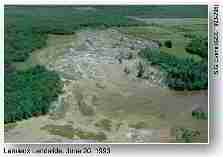 Unstable clay soils found in some areas of Quebec and eastern Ontario (also found in Rissa, Norway) can "spontaneously liquefy with little or no provocation", leading to sudden catastrophic sinkhole formation and soil collapse reported the New York Times 13 May 2010).
Unstable clay soils found in some areas of Quebec and eastern Ontario (also found in Rissa, Norway) can "spontaneously liquefy with little or no provocation", leading to sudden catastrophic sinkhole formation and soil collapse reported the New York Times 13 May 2010).
The Times article reports the tragic death of the Richard Préfontaine family when on May 11, 2010 their home suddenly fell into a mud crater 100 feet deep hole approximately 900 feet by 1700 feet in size. More than 250 such collapses have been identified in this area of Canada.
The Lemieux landslide photo (left) of an earlier unstable clay soil or quick clay landslide is from the Canadian Department of Natural Resources.
The May 2010 Times article explained that because the unstable clay formed in salt water the molecular structure of its particles is unstable (compared with clays formed as layers in fresh water). When an event breaks the molecular bonds between clay particles the clay can spontaneously liquefy.
The same Times article reported another clay liquefication collapse in St. Jean Vianney, Quebec in 1971, when 31 people died and 40 homes were destroyed, and continued that the town of Lemieux, Ontario (east of Ottawa) was relocated in 1991 due to concern for unstable clay soils that two years later collapsed over a 42-acre area.
See SINKHOLES in QUEBE, LEDA CLAY for a detailed article on unstable clay soils in Quebec & Eastern Ontario.
Hydraulic Fracturing Temblors & Sinkholes in England related to underlying chalk formations
See Sinkholes & Temblors in Ohio for a New York Times news article citing the occurrece of oil and gas well fracking and disposal well activity traced to local earthquakes or temblors.
- Boulter, M. C., and W. G. Chaloner. "Neogene fossil plants from Derbyshire (England)." Review of Palaeobotany and Palynology 10, no. 1 (1970): 61-78. -
Abstract
An area around Horndean in SE Hampshire, England, has been studied to determine the reasons for an unusually high density of sinkholes related to dissolution of the underlying chalk. Ground investigations and excavations for a variety of engineering and construction projects in this area have provided detailed information that gives an insight into their formation and development.
Contouring of the chalk surface indicates the presence of a north–south-trending palaeovalley, beneath Tertiary cover deposits, to the south of Horndean.
The significance of this feature to chalk karstification and continuing sinkhole development is discussed, along with the significance of other geological factors, such as fracture zones in the chalk and the nature and distribution of cover deposits. This forms the basis of a risk assessment of ground subsidence in this area, with particular reference to collapse.
The engineering significance of the sinkholes and the design of ground investigations are discussed in the light of experience gained from past projects in this area and the established risk of pollution of the chalk aquifer - Edmonds, Clive N. "Karst and mining geohazards with particular reference to the Chalk outcrop, England." Quarterly Journal of Engineering Geology and Hydrogeology 41, no. 3 (2008): 261-278.
- McDowell, P. W., J. Coulton, Clive N. Edmonds, and A. J. Poulsom. "The nature, formation and engineering significance of sinkholes related to dissolution of chalk in SE Hampshire, England." Quarterly Journal of Engineering Geology and Hydrogeology 41, no. 3 (2008): 279-290. Abstract
An area around Horndean in SE Hampshire, England, has been studied to determine the reasons for an unusually high density of sinkholes related to dissolution of the underlying chalk. Ground investigations and excavations for a variety of engineering and construction projects in this area have provided detailed information that gives an insight into their formation and development. Contouring of the chalk surface indicates the presence of a north–south-trending palaeovalley, beneath Tertiary cover deposits, to the south of Horndean.
The significance of this feature to chalk karstification and continuing sinkhole development is discussed, along with the significance of other geological factors, such as fracture zones in the chalk and the nature and distribution of cover deposits.
This forms the basis of a risk assessment of ground subsidence in this area, with particular reference to collapse. The engineering significance of the sinkholes and the design of ground investigations are discussed in the light of experience gained from past projects in this area and the established risk of pollution of the chalk aquifer - Modelling the influence of solution-enhanced conduits on catchment-scale contaminant transport in the Hertfordshire Chalk aquifer Geological Society, London, Special Publications, January 1, 2012, v. 364:205-225
- Paukštys, Bernardas, Anthony H. Cooper, and Jurga Arustiene. "Planning for gypsum geohazards in Lithuania and England." Engineering Geology 52, no. 1 (1999): 93-103.
- Waltham, Tony, The Yorkshire Dales: Landscape and Geology, Crowood Press ( 2007) ISBN-10: 1861269722 ISBN-13: 978-1861269720
- XVI, CANAG1P N. GECGRAPMER. "The analysis of growth patterns of two-generation populations: the example of karst sinkholes." (1972). Excerpt: An example is the pattern of karst sinkhole distribution in the central Mendip Hills, England. 493 sinkholes, the total population, were classified into Group 1 (mother) and Group 2 (daughter) features (Ford 1964), ....
Sinkholes in Estonia - the Witch's Well in Tuhala
Sinkholes occur in many parts of the world, and often from similar underlying geological formations.
The New York Times described the Witch's Well in Tuhala, Estonia as caused by a combination of a large field of porous karst combined with water from fifteen underground rivers, a "maze of caverns", and periodic flooding ground water during periods of heavy rains.
Sinkholes in the Tuhala area include the "Horse's hole" (1978) and the "Mother-in-Law's hole" and the Times also reported that streams appear and disappear "like phantoms." (See Hannu Oittinen's photo in the NY Times article and other photos in our references below.)
Although some local people enjoy the magic of curative waters roiling unbidden to the surface of the Witches Well in Tuhhala when underground witches are fighting, or by other accounts, when the witches are flogging themselves with birch branches in an under-earth sauna, the Witch's well in Tuhala, Estonia is an episodic upsurge well through which nearby river and marsh water is pushed to the surface when rainwater floods the porous karst field below the well.
Because the up-flow of water in this Tuhala well is caused by increased water pressure from high water levels in the nearby underground Tuhala river rather than by pressure from groundwater, the Witches' well is not a true artesian well. Water flows up through the Witches' well at hundreds of liters per minute during these eruptions.
The Witches' well is normally fed by the Kuhala underground river (1.5 km away) through the karst field and through nearby bogs.
On occasion, during years of heavy spring floods and sometimes in other seasons, when the Tuhala river flow is increased by local rains to exceed 5000 liters/second, it causes the Witches' well to send water flowing to the surface.
Water from the Witches' well is muddy brown as it is fed from the Tuhala river through nearby marshes to porous karst below the well.
For thousands of years people living in the area have believed that water from these erupting springs is holy, able to cure blindness, remove freckles, or increase longevity.
(Tuhala, a very old city that includes 500-year old farmhouses, has been occupied for roughly 3,000 years, and includes eleven prehistoric camps or settlements, cult stones, and Estonia's oldest log road (Heinasoo bog).)
The history of water usage in Estonia is given by a citation in ourReferences or Citations .
Characteristic of worldwide growing problems with severe loss of ground water due to pumping-out by water mining companies, this concern faces Tuhala as well, where a nearby quarry may lead to significant drops in ground water that may be more serious for owners than simply the loss of the fun of the Witches' well eruptions.
Sinkholes in Florida

Source: USGS
Florida has More Sinkholes than any other state among the United States.
They are an obvious feature of Florida's natural karst topography. The Floridian aquifer, a karst formation, covers about 100,000 square miles, and provides drinking water to residents of that state.
A sinkhole in Winter Park Florida opened beneath the city swimming pool in 1981 and formed an enormous subsidence. A second, round and more classical sinkhole opened in Mulberry, Florida.
What the Florida Karst and sinkhole discussion sometimes fails to include is the increase in sinkholes in Florida due to increased development and the pumping of groundwater in that state. A water table that falls (or rises) by significant amounts will cause an increase in the formation of sinkholes.
Florida's sinkholes also include phantom lakes or "ghost lakes" such as Lake Jackson. Quoting the Florida DEP & the Florida Geological Survey - FGS.
On September 16, 1999, much of the central portion of Lake Jackson, a large lake on Tallahassee’s northern side, drained down an eight-foot-diameter sinkhole known as Porter Hole. Sinkholes in Lake Jackson open and drain portions of the lake approximately every 25 years.
Following the September 1999 event, the FGS, in cooperation with the Northwest Florida Water Management District, Leon County, and theA picture of Geologists entering Porter Sinkhole in Tallahassee, Florida Florida State University Department of Geological Sciences began investigating this phenomenon.
This investigation will improve our understanding of the connection between Lake Jackson and the Floridan aquifer system, which provides most of the area’s drinking water.
... The sink consists of a series of convoluted passages through the limestone, with various conduits intersecting the main sink. The FGS has drilled four vertical core holes to depths from 105 feet to 119 feet below the lakebed. Interpretation and analysis of the cores continues and will be published by the FGS upon completion.
Details about how sinkoles form in Florida are
at SINKHOLES on KARST FORMATIONS where we discuss Florida sink holes, detection, cause, remedy, at length.
Also see GHOST LAKES & SINKHOLES.
Sinkhole Repair Services in Florida
Watch out: Readers trying to diagnose and deal with sudden soil subsidence or yard collapses should
see SINKHOLES - IMMEDIATE SAFETY ACTIONS.
Call your local building department for advice on prompt sinkhole assessment as well as for their advice about which excavation contractors or foundation repair contractors in your immediate area have experience with sinkhole diagnosis and repair.
In some circumstances you may need to contact an engineering firm who have sinkhole expertise, typically listed under civil engineers or geotechnical engineer.
Companies that identify themselves as sinkhole damage repair experts in Floria are listed
Sinkholes in Georgia
Sinkholes have been reported in Georgia including news articles in the Examiner (a freelance writing website) in 2014 describing an event in Atlanta that could have been related to human activity (even a burst water main) though the report attributed it to the presence of a stretch zone in the North American Tectonic plate.
See details at SINKHOLES in GEORGIA.
Sinkholes in Guatemala
Associated Press reported (2 June 2010) that an enormous sinkhole opened suddenly in Guatemala City, Guatemala. The hole, nearly perfectly round, was estimated at 66 feet in diameter and 100 feet deep. (Wikipedia reported that the sinkhole is 200 feet deep.) Other reports assert that heavy tropical rains from the storm Agatha triggered the collapse of this sinkhole.
National Geographic and Wikipedia both report that Guatemala City, the location of the giant sinkhole is also the location of a 2007 sinkhole that was 330 feet deep. Guatemala city is built on soils comprised of volcanic ash that has not solidified into rock.
We wondered if volcanic ash or pumice (Guatemala city is built atop a thick layer of loose pumice) may in periods of flooding (such as 2010 tropical storm Agatha) become unstable in a manner similar to the sudden liquification of high-water-content clay discussed
at SINKHOLES in QUEBEC, LEDA CLAY
But Bonis' explanation (below) seems the most credible to date.
It is apparent and the media report implied that the sudden development of this sinkhole in Guatemala was related to weather conditions, including heavy rains, occurring in the area when tropical storm Agatha reached the Guatemala/Mexico border shortly before.
In other areas (Guatemala, Honduras, Mexico) that tropical storm caused landslides and led to at least 150 deaths in Guatemala alone. But more than sudden rainfall was at work in causing this sinkhole.
The very round shape of that sinkhole indeed suggests that there was a pre-existing condition or geological formation, perhaps related to a history of water drainage in that location. Two Guatemalan sinkhole explanations are provided here:
Wikipedia reported (June 2010) that four volcanoes are visible from the city, two of them active. The nearest and most active is Pacaya, which at times expels a considerable amount of ash.
That source also reports that "Geologist Sam Bonis suggests that the recurring "sinkholes" in Guatemala are, as others have suggested, caused by sewer leaks eroding Guatemala's soft soil rich in volcanic ash. As such Bonis does not consider the features sinkholes proper, instead calling them a "piping feature" of Guatemala's aged sewer system."
Offering a second sink hole explanation that is a bit harder to swallow, Vanity Fair, consulting with David Bercovici and Mark Brandon, both professors of geology and geophysics at Yale University, reported that water collected and ate away at the "bedrock" and added the explanation that water had collected in a depression (presumably and unexplained, the depression itself was perfectly round) for some time, dissolving the underlying rock for some time before the sudden collapse.
Just why a depression under a paved city intersection in Guatemala City developed in the shape of a nearly-perfectly-round water collection point occurred below ground at that single location and at that depth could benefit from added detail.
Nonetheless, the experts' observation that there was a pre-existing water drainage pathway that had been in fact developing for a long time, combined with recent flooding to produce the sudden and deep collapse is helpful in understanding this very round and very deep sinkhole event. One would expect further sudden sinkholes to appear under these conditions.
In sum, the most likely explanation of the Guatemala City sinkholes is the combination of the Bonis explanation, combined with sudden heavy rainfall that leads to the collapse of a previously-undermined area.
Sinkholes in Iceland
At Iceland's Jokulsa river is a 150-foot inverted-funnel-shaped "sinkhole" formed by steam produced by one of Iceland's numerous geothermal vents.
Sinkholes in Kansas
Treece Kansas Sinkholes & Land Subsidence - Lead & Zinc Mines
In 2012 the New York Times Magazine provided an excellent summary of the history of Treece Kansas, including a description of the occurrences of sinkholes and sudden subsidences in Treece traced to lead and zinc mining operations, environmental contamnation issues (primarily lead), and ultimately the shut-down and abandonment of the town.
Mining for lead and zinc began following discovery of those metals by the Pitcher Lead Company (Joplin MO) in 1919, and peaked during World War II.
The mines were exhausted by the 1960's, and by 1981, the U.S. EPA had classified Treece and its surrounding area as "... the most contaminated in the country" [6]
Our satellite image of Treece Kansas (see pointer A), adapted from Google Maps, illustrates the effects of surface mining operations in the area, and our second map (below) provides a closer look at a mining area just southeast of the town.
While the Times Magazine article focuses on environmental issues surrounding Treece Kansas. Here we cite subsidence and sinkholes descrbed in the article.
Following a pattern we describe here for other towns and cities around the world, when mining operations were abandoned, pumps that had been operated to keep water from filling the mining excavations were shut down.
In turn, water entering the mines appears to play a significant role in subsequent appearance of subsidences and sinkholes ranging in size from a modest "sofa sized" to a 300 ft. wide xby 200 foot deep sinkhole that opened in 1966.
A second cause of sudden subsidences and sinkholes in areas of mining operations is the presence of shallow underground mines of any type (zinc, lead, or more often, coal mines) that are covered by soils thin enough that the surface simply collapses into the excavated area.
Shallow mine collapses are common in Oklahoma, Kansas, Missouri and Pennsylvania.
South from Treece Kansas and across the state line in Pitcher, Oklahoma, is one of the world's more famous sinkholes, the Pitcher Oklahoma sinkhole, subsidences also caused by lead and zinc mining operations.
Sinkholes in Kentucky
In March 2014 the New York Times reported on a dramatic and sudden sinkhole collapse at the National Corvette Museum in Bowling Green KY: a sinkhole opened in the museum's Skydome area on February 12th of that year.
Security cameras captured the sinkhole collapse and the falling of a number of the museum's Corvettes into a 40-foot deep round crater. Un-daunted museum officials used a crane to recover the cars from the collapse in preparation for sending them for repair and restoration.
Sinkholes are common in Kentucky where portions of the state are underlaid with karst formations.
See details at SINKHOLES on KARST FORMATIONS.
But interesting in the Times article was the report of the supervisor of a construction company supervising the recovery of the automobiles.
According to the Times, whose reporter interviewed G Michael Murphy,
... in the past, in most construction surveying, crews would bore down to bedrock and then stop drilling. But in a karst area, there may be an open space under several feet of solid rock. In this case [the Corvett Museum sinkhole collapse in Bowling Green], there was a void under a bridge layer of bedrock, and when it collapsed, the floor caved in and took the cars with it.
It would seem advisable for construction companies and excavators working in areas of known karst formations and sinkhole collapse risk to be a bit leery of building atop "bedrock" without further geotechnical engineering evaluation of the conditions below in an effort to reduce the chances of a sudden "bridge layer" of "bedrock" collapsing over an open karst formation.
Indeed the Times report continues with an observation that at the Corvette museum the space beneath the 20-year old building will be tested further using a microgravity machine capable of detecting voids below the foundation and floors of the structure.
Kentucky Sinkhole Research
- Burton, Jerry, "Fresh From a Kentucky Sinkhole, Recovered 'Vettes Draw Crowds", The New York Times, 3/23/2014 p. 2
- Dinger, James S., and James R. Rebmann. Ordinance for the control of urban development in sinkhole areas in the Blue Grass karst region, Lexington, Kentucky. Kentucky Geological Survey, 1991.
- Florea, Lee J., Randall L. Paylor, Larry Simpson, and Jason Gulley. "Karst GIS advances in Kentucky." Journal of Cave and Karst Studies 64, no. 1 (2002): 58-62.
- Florea, Lee J. "Using State-wide GIS data to identify the coincidence betwen sinkholes and geologic structure." Journal of Cave and Karst Studies 67, no. 2 (2005): 120-124.
- Hess, Jonn W., and William B. White. "Storm response of the karstic carbonate aquifer of southcentral Kentucky." Journal of Hydrology 99, no. 3 (1988): 235-252.
- Waltham, Tony, Frederic Gladstone Bell, and M. G. Culshaw, Sinkholes and subsidence, Springer/Praxis, 2005.
- White, William B., Richard A. Watson, E. R. Pohl, and Roger Brucker. "The central Kentucky karst." Geographical Review (1970): 88-115.
- [2] Center for Cave and Karst Studies or the Kentucky Climate Center, both at Western Kentucky University
- [8] http://kyclim.wku.edu/BRADD/sinkholes/intro.html Sinkhole explanation and warning signs- Kentucky
Sinkholes in Puerto Rico
The Island of Puerto Rico has many natural sinkholes such as the one we photographed just above.
Puerto Rico's largest karst area extends along length the northern coast of the island from its western tip nearly to San Juan, and from the northern coast down about 1/3 of the island's width. (Kambesis 2020)
This sinkhole, observed in early 2023 has opened along the Northwestern coast of Terranova, a barrio located in the municipaliuty of Quebradillas, Puerto Rico over what is the largest coastal Karst fomation along the island.
Below: while sinkholes in Puerto Rico sometimes form tourist attractions, in this instance our bird tour group stood along the fence admiring seabirds, turning their backs on the subsidence just a few meters away.
[Click to enlarge any image]
Looking at the same Puerto Rico sinkhole from another viewpoint we see that it is quite close to an existing home - something that made the author [DF] a bit nervous.
Puerto Rico Sinkholes Research
- Beck, Barry F. Sinkholes: their geology, engineering and environmental impact [PDF] Proceedings of the First Multidisciplinary Conferente on Smkholes/Orlando/Florida 117 (1984).
- Colon, Carmen Maria Reyes. Bryoflora of limestone sinkholes in the north-central karst zone of Puerto Rico. University of Puerto Rico, Mayaguez (Puerto Rico), 2000.
- Kambesis, Patricia, Ira D. Sasowsky, and Brittiny P. Moore. SINKHOLES AND KARST IN PUERTO RICO: PICTURESQUE AND PROBLEMATIC [PDF] (2020). 16th Sinkhole Conference, NCKRI Symposium, University of South Florida (USF) Scholar Commons, DOI doi.org/10.5038/9781733375313.1055
Abstract
The karst landscapes of Puerto Rico cover nearly 30% of the island, occurring on the north and south coasts and in small patches throughout the central part of the Commonwealth.
The karst is expressed through dramatic inland and coastal landforms, extensive limestone aquifers, coastal wetlands and estuaries, and through the many caves and cave systems that drain the landscape. An important feature of Puerto Rico’s karst are sinkholes which form from a variety of processes including dissolution of underlying strata, collapse of subterranean voids, and landslides.
From a touristic perspective, sinkholes have served as major attractions in Puerto Rico i.e. Tres Pueblos Sinkhole, Arecibo Observatory telescope located within a large sinkhole, and the route of the Rio Tanama through a series of collapsed sinkholes.
Analysis of sinkhole occurrence and density have shown that sinkhole development is a measure of karstification.
However, despite touristic and academic interest, sinkholes pose major challenges to land development and are also subject to human impact. In the most extensive karst area, on the North Coast, it is reported that there are over 4,300 documented sinkholes, giving a sinkhole density of 5.4/km2 with a mean sinkhole depth of 19 m.
Improved availability of digital terrain, and other GIS data, allow a fresh look at karstification of the island and the ever-growing impact of human development on the karst. Typical problems include groundwater contamination, foundation instability, and storm-induced road collapses. - Lugo, Ariel E., Leopoldo Miranda Castro, Abel Vale, Tania del Mar López, Enrique Hernández Prieto, Andrés García Martinó, Alberto R. Puente Rolón et al. "Puerto Rican karst-a vital resource." (2001).
- Palm, Risa, and Michael E. Hodgson. "Natural Hazards in Puerto Rico." Geographical Review (1993): 280-289.
- Pérez, Mervin, and Inés Sastre-De Jesús. "Sinkholes important bryophyte areas: The case of the Guajataca Commonwealth Forest in Puerto Rico." Evansia 26, no. 2 (2009): 45-49.
Sinkholes in Lisbon, Portugal
In 2003 a sudden sinkhole opened in a Lisbon street, apparently caused by water flow beneath the city surface. A bus fell into this urban sinkhole.
Sinkholes in Lithuania
- Paukštys, Bernardas, Anthony H. Cooper, and Jurga Arustiene. "Planning for gypsum geohazards in Lithuania and England." Engineering Geology 52, no. 1 (1999): 93-103.
Sinkholes in Maryland
Where do Sinkholes Occur in Maryland? See details
Sinkholes in Mexico
Mexico's Ik Kil Cenote (a natural well) is located close to Chichen Itza in the Yucatan Penisula. This and other cenotes were described by Richard Halliburton.
Sinkholes in Minnesota
Details about sinkholes in Minnesota are now found at SINKHOLES in MINNESOTA where we also
discuss SEAWALL SINKHOLES & SUBSIDENCES.
Sinkholes in Missouri
The chart of sinkhole occurrences in Missouri shown here (chart at left) is reproduced from Foundation Engineering Problems and Hazards in Karst Terranes, James P. Reger, Maryland Geological Survey, web search 06/05/2010, original source: http://www.mgs.md.gov/esic/fs/fs11.html
Missouri Sinkhole Research
- Williams, J. H. and Vineyard, J. D., 1976, Geologic indicators of subsidence and collapse in karst terrain in Missouri: Presentation at the 55th Annual Meeting, Transportation Research Board, Washington, D.C.
Sinkholes in New York
See SINKHOLES in NEW YORK for examples of a sudden soil subsidence in New York. Details of this case and our advice on what to do about this sudden yard collapse are provided.
Sinkholes? & Earthquakes in Oklahoma
Hydraulic Fracturing Temblors in Oklahoma
Sinkholes & Temblors in Ohio
In March 2014 the New York Times reported that Ohio officials were investigating the use of fracturing or "fracking" for the development of oil and gas resources in the state may have caused two temblors or earthquakes measuring 2.6 and 2.0 magnitude.
Hydraulic fracking was in process at the time and in the area of the temblors. The Times article noted that
Over the past decade, shale oil and gas production has been linked to earthquakes in Ohio, Arkansas, Oklahoma and other states and in several countries. In most cases, however, the quakes were tied to disposal wells ...
The water [injected into disposal wells] is thought to alter pressures underground and unclamp old faults, allowing them to slip. ... [there have been] ... a few instances - in British Columbia, England and south-central Oklahoma - in which the fracking itself was thought to have induced quakes large enough to be felt. - The New York Times, A20, 3/11/2014
Ohio Sinkhole Research
- Henry Fountain, "Ohio Looks at Whether Fracking Led to 2 Quakes", The New York Times, p. A20, 3/12/2014
Sinkholes in Pennsylvania
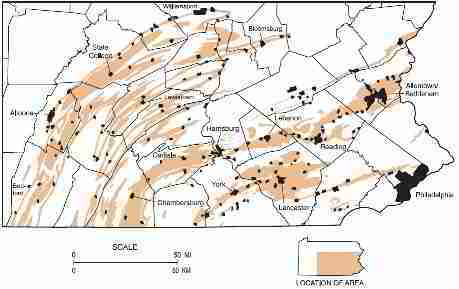
Sudden subsidences and sinkholes in some areas of Pennsylvania have been associated with coal mining activities combined with surface and subsurface water drainage or pumping.
Details are at SINKHOLES in PENNSYLVANIA
What are Ghost Lakes and how do they Relate to Sinkholes?
Ghost lakes form in some areas over limestone that has previously been partially dissolved to leave a network of water-draining passages in rock
. On occasion water passages may become clogged, perhaps with surface soils and debris, leading to lakes that form, then later disappear if the drainage clogs open again.
The September 1999 Lake Jackson sinkhole near Tallahassee Florida drained the lake into a 50-foot deep sinkhole.
Before it was drained by this sinkhole, the lake covered six square miles. The Florida Geological Survey (FGS) indicates that Lake Jackson drains and refills every twenty-five years.
OPINION-DF: As Kochanov explains, acidic rainwater is formed by the interaction of atmospheric moisture with carbon dioxide to form carbonic acid.
As global warming is associated with increased atmospheric levels of carbon dioxide (CO2), we might expect an increase in the acidity of rainfall that in turn may increase the incidence of sinkholes where carbonate bedrock (limestone) is prevalent.
Causes of Soil Subsidence & Building Movement Not Due to Sinkholes
See the full article on this topic at SINKING BUILDINGS Excerpts are below.
Kochanov, W.E. lists and we elaborate here a variety of subsidences that are not caused by naturally-occurring sinkholes, followed by examples of sinking houses not caused by sinkholes, and examples of cesspool or septic system collapses.
- Natural soil settlement under and around new construction, potentially causing severe damage if soils were improperly compacted below a foundation, for example.
- Subsidence and structural movement due to building expansions built over old cisterns, wells, or cesspools.
- Local drainage areas or springs
- Burrowing animals (groundhogs) -
see GOPHER HOLE DAMAGE - Abandoned mines, underground mining activities
- Broken water mains or sewer mains can undermine streets and sidewalks, leading to sudden catastrophic collapse of streets, sidewalks, or nearby properties, at times consuming people or even vehicles and causing injury and even death [3]
Understanding the cause of a sinkhole assists in knowing what to expect in the future and in planning for building or sink hole repairs. An important key to identifying a sinkhole area is to consider the location of carbonate bedrock.
Watch out: significant building movement may be caused by a variety of problems other than sinkholes. Some of these are equally dangerous, and expert evaluation is important. Consult with a structural engineer who is specifically familiar with building and foundation movement and failures.
Examples of conditions that can raise serious, urgent concerns for safety and risk of sudden, catastrophic building collapse include at least the following:
- Cracks and bowing in structural brick walls. Not all masonry wall cracks are dangerous, but if the bond courses are broken in a structural brick wall (for example if there is bulging), the building may be in very dangerous, unstable condition and at risk of sudden collapse.
- Sudden significant building movement
- Large cracks, bulges, bowed walls that may indicate sufficient movement to have damaged structural connections
- Damage from flooding, earthquake, etc.
- Nearby excavation that undermines the foundation of an existing building
- Soil undermining by burst water main
Watch out: Immediately rope off the area of any soil subsidence or suspected old septic tank or cesspool area, and mark it plainly as unsafe so that a wandering neighbor, adult or child, does not go near nor fall into this hole. It could be quite dangerous.
See CESSPOOL SAFETY WARNINGS for examples of potentially fatal cesspool collapse hazards.
Sinkholes in Texas
Notes on the Dasietta Texas Sinkhole Reported in May 2008 - the "Sinkhole de Mayo"
The Texas Dasietta Sinkhole which appeared suddenly and apparently with no warning on May 8, 2008 in Dasietta Texas. New York Times reported that after only about two days the Dasietta Texas sinkhole covered an area of 600 x 525 feet, or about 1/10 of a square mile.
At the time of the May 9th report, experts didn't know if the sinkhole had stopped growing, but Carl Norman, a geologist at U. Houston reported in the Times that the sink hole could become stable or it could collapse further in six months, doubling in size.
The salt dome over which the Dasietta Texas sinkhole is located was estimated to be six miles in diameter.
It was posed that while this sinkhole collapse could be due to entirely natural causes, the the practice of disposal of waste saltwater produced by oil drilling operations by pumping the wastewater into the ground might be contributing to or even causing the Dasietta sinkhole by dissolving underground salt. -- Ref: "Sinkhole and Town: Now You See It ...", New York Times, p. A-15, 9 May 2008.
Property inspectors working in Texas in areas of construction over salt domes or where oil drilling may be both extracting oil from and inserting wastewater into the soil need to be particularly vigilant and should caution home owners or home buyers about the risk of sudden sinkhole development.
Texas Sinkhole Research
- Beck, B. F. (2005). Sinkholes and the Engineering and Envrionmental Impacts of Karst. San Antonio, Texas: The American Society of Civil Engineers.
Reader Comments, Questions & Answers About The Article Above
Below you will find questions and answers previously posted on this page at its page bottom reader comment box.
Reader Q&A - also see RECOMMENDED ARTICLES & FAQs
On 2018-05-21 - by (mod) - Sinkholes certainly occur in and around San Antonio TX
Jesu
Sinkholes certainly occur in and around San Antonio TX
Some "sinkholes" that are not true geologically-based sinkholes, such as those caused by a burst or leaking sewer lines or water mains can still be very dangerous.
In December 2016 in a tragic and rare death, a San Antonio sherrif's deputy died when her car fell into a Southside San Antonio sinkhole on Quintara Road.
If you suspect a sinkhole in or near your property you should
1. rope off the area from well away and keep everyone away from the area
2. notify San Antonio authorities including your local
Emergency services - dial 311 (210.207.6000 outside city limits)
and/or
San Antonio police department 210.207.7360
Or the San Antonio Department of Emergency Management 210.206.8580
Emergency management is a comprehensive system to respond to emergencies or disasters impacting our community.
On 2018-05-21 by Jesu Recio
I live in an apartment complex and when it rains it always floods in front of my apartment. Today we had heavy rain and I noticed air bubbles coming from the ground. There has been recent sink holes around San Antonio and I'm reaching out in concern for my families saftey.
I have video of the air bubbles which are a steady flow coming up. I've lived here a few years and this is the first I've seen.
If you know or know of any organization that can determine if a sink hole is possible please contact me at 210-919-3897, the apartments I live in are Country Oaks Apartment in San Antonio, TX off of Ackerman rd. My name is Jesus Recio
Sinkholes in Tennessee
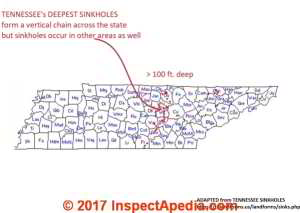 Reader Question:
Reader Question:
Sep 15, 2017
We live in Tiptonville TN, about an eight of a mile from Reelfoot lake. We have noticed that our front door is now dragging the floor when we start to shut it. the front porch is slumping, and our yard is slumping in some spots.
We don't know if this is from the small earthquakes that we have quit often, or if it may be a possible sinkhole
...The map above shows the general area of Tennessee's deepest sinkholes, over 100 ft., retrieved 2017/09/17, original source:https://tnlandforms.us/landforms/sinks.php
[Click to enlarge any image]
Reply: sinkholes occuring in Tennessee
There are indeed reports of earthquakes around Tiptonville TN, just as you said and as I've read.
We provide details on Tennessee sinkholes and subsidences
at SINKHOLES in TENNESSEE
Sinkholes in Virginia
Please see SINKHOLES in VIRGINIA
The Virginia Department of Mines, Minerals, and Energy reports that sinkholes have been reported in that state since colonial times.
Sinkholes in Berezniki Russia - 24-hour Monitoring
In 2012 the New York Times reported that the city of Berezniki, Russia has a severe and sudden sinkhole problem that defies corrective measures and has prompted the dity to staff a 24-hour sink hole watch, using video monitors of Berezniki areas to observe, report, and issue warnings to the city's residents when a sinkhole begins to appear.[5]
The Times reporter, Andrew E.Kramer, who has reported on sinkholes in Russia before [3], explained that extensive and deep (750 - 1,500 feet) potash (fertilizer) mining operations below Berezniki, a city of 154,000 that began as a labor camp, placed mines within walking distance of the original city center.
The presence of deep mines below the city combined with lack of application of mine construction safety standards, mine supports that depend on pillars of material that is soluble and thus can collapse during flooding, led to trouble when fresh water began flowing into the mine from a spring in 2006.
The "Grandfather", a Berezinski Russia sinkhole that opened 2007 is 340 x 430 yards in size and 780 feet deep. This sinkhole may, according to Kramer, be the largest manmade sinkhole in the world. It required the evacuation of rougly 2000 people. - The New York Times [5]
Daniel Friedman - Florida Suncoast ASHI Educational Seminar - 1 May 2004, updated 2007, 2008, 2014, 2017. Portions of this text are extracted, quoted, or paraphrased from references provided; a key resource author was Sarah Cervone at Reference-1. The text document is InspectAPedia.com /vision/Sinkholes_Subsidences.php - © 2017 - 2004 Daniel Friedman All Rights Reserved
Sinkholes and Sudden Land Subsidence References, Products, Consultants
- Barry F. Beck, A. J. (1999). Hydrogeology and Engineering Geology of Sinkholes and Karst. Rotterdam, Netherlands: A. A. Balkema.
- "A Hole in the Ground Erupts, to Estonia's Delight", New York Times, 9 December 2008 p. 10.Florida DEP - Department of Environmental Protection, & Florida Geological survey (http://www.dep.state.fl.us/geology/default.htm) on Florida sinkholes: Effects of Sinkholes on Water Conditions Hernando County, Florida, Brett Buff, GIS in Water Resources, 2008, Dr. David R. Maidment, Photos - Tom Scott, Florida Geographic Survey - Web Search 06/09/2010 -
http://www.dep.state.fl.us/geology/geologictopics/jacksonsink.htm
and - http://www.dep.state.fl.us/geology/geologictopics/sinkhole.htm
also see
Lane, Ed, 1986, Karst in Florida: Florida Geological Survey Special Publication 29, 100 p. - History of water usage in Estonia: (5.7 MB PDF) jaagupi.parnu.ee/freshwater/doc/the_history_of_water_usage_systems_in_estonia.pdf
- Foundation Engineering Problems and Hazards in Karst Terranes, James P. Reger, Maryland Geological Survey, web search 06/05/2010, original source: http://www.mgs.md.gov/esic/fs/fs11.html
Maryland Geological Survey, 2300 St. Paul Street, Baltimore, MD 21218 - "Frost Heaving Forces in Leda Clay", Penner, E., Division of Building Research, National Research Council of Canada, Canadian Geotechnical Journal, NRC Research Press, 1970-2, Vol 7, No 1, PP 8-16, National Research Council of Canada, Accession number 1970-023601, Quoting from original source
The frost heaving forces developed under a 1 ft. (30.5 cm) diameter steel plate were measured in the field throughout one winter.
The steel plate was fixed at the ground surface with a rock-anchored reaction frame. heave gauges and thermocouples were installed at various depths to determine the position and temperature of the active heaving zone.
The general trend was for the surface force to increase as the winter progressed. when the frost line approached the maximum depth the force was in excess of 30,000 lb (13,608 KG). Estimates of the heaving pressure at the frost line ranged from 7 to 12 psi (0.49 to 0.84 KG/cm) square during this period.
The variation of surface heaving force was closely associated with weather conditions. Warming trends resulting in a temperature increase of the frozen layer caused the forces to decline.
- "Geoscape Ottowa-Gatineau Landslides", Canada Department of Natural Resources, original source http://geoscape.nrcan.gc.ca/ottawa/landslides_e.php - quoting from that source:
Leda clay slopes in the Ottawa valley are vulnerable to catastrophic landslides. More than 250 landslides, historical and ancient, large and small, have been identified within 60 km of Ottawa.
Some of these landslides caused deaths, injuries, and property damage, and their impact extended far beyond the site of the original failure. In spectacular flowslides, the sediment underlying large areas of flat land adjacent to unstable slopes liquefies.
The debris may flow up to several kilometres, damming rivers and causing flooding, siltation, and water-quality problems or damaging infrastructure. Geologists and geotechnical engineers can identify potential landslide areas, and appropriate land-use zoning and protective engineering works can reduce the risk to property and people.Deposits of Leda clay, a potentially unstable material, underlie extensive areas of the Ottawa-Gatineau region. Leda clay is composed of clay- and silt-sized particles of bedrock that were finely ground by glaciers and washed into the Champlain Sea.
As the particles settled through the salty water, they were attracted to one another and formed loose clusters that fell to the seafloor.
The resulting sediment had a loose but strong framework that was capable of retaining a large amount of water. Following the retreat of the sea, the salts that originally contributed to the bonding of the particles were slowly removed (leached) by fresh water filtering through the ground. If sufficiently disturbed, the leached Leda clay, a weak but water-rich sediment, may liquefy and become a 'quick clay'.
Trigger disturbances include river erosion, increases in pore-water pressure (especially during periods of high rainfall or rapid snowmelt), earthquakes, and human activities such as excavation and construction.After an initial failure removes the stiffer, weathered crust, the sensitive clay liquefies and collapses, flowing away from the scar. Failures continue in a domino-like fashion, rapidly eating back into the flat land lying behind the failed slope. The flowing mud may raft intact pieces of the stiffer surface material for great distances.
- [2] Kentucky University, Center for Cave and Karst Studies or the Kentucky Climate Center, both at Western Kentucky University
- Kochanov, W. E., 1999, Sinkholes in Pennsylvania: Pennsylvania
Geological Survey, 4th ser., Educational Series 11,
33 p., 3rd printing April 2005, Pennsylvania Department of Conservation and Natural Resources / Bureau of Topographic and Geologic Survey, DCNR Educational Series 11, Pennsylvania Geological Survey, Fourth Series, Harrisburg,
1999 - web search 06/05/2010, original source: http://www.dcnr.state.pa.us/topogeo/hazards/es11.pdf -
Quoting from the document introduction:
The first 18 pages of this booklet contain an explanation of how sinkholes develop. In order to tell the sinkhole story, it is important to discuss a number of related geologic disciplines.
The words used to describe sinkholes and these disciplines may be a bit unfamiliar. However, general explanations are given throughout the booklet to help clarify their meanings. Key words are printed in bold type for emphasis.
The more important ones are defined in a Glossary that begins on page 29. The remaining sections, starting with “Sinkholes in the Urban Environment” (page 18), deal with sinkholes and their impact on our environment. This includes recognition of subsidence features and sinkhole repair. - "Quebec Family Dies as Home Vanishes Into Crater, in Reminder of Hidden Menace", Ian Austen, New York Times, 13 May 2010 p. A8. See http://www.nytimes.com/
- "Quick Clay", Wikipedia search 5/13/2010 - http://en.wikipedia.org/wiki/Quick_clay
- [1] Sarah Cervone, [web page] data from the APIRS database, Graphics by Ann Murray, Sara Reinhart and Vic Ramey, Vic Ramey is the editor. DEP review by Jeff Schardt and Judy Ludlow. The web page is a collaboration of the Center for Aquatic and Invasive Plants, University of Florida, and the Bureau of Invasive Plant Management, Florida Department of Environmental Protection contact: varamey@nersp.nerdc.ufl.edu [A primary resource for this article
- Vanity Fair - web search 06/04/2010 http://www.vanityfair.com/online/daily/2010/06/what-caused-the-guatemala-sinkhole-and-why-is-it-so-round.html
- See additional sources at the end of this page atReferences or Citations
Sink Hole Research, Engineering References
- Ashley, George H. Memorial of Albert Homer PURDUE [PDF] In Proceedings of the Indiana Academy of Science, vol. 28, pp. 247-257. 1918.
- Beck BF. 1986. A generalized genetic framework for the development of sinkholes and Karst in Florida, U.S.A. Environmental Geology and Water Sciences 8 (2): 5-18.
- Green, Tamsin. DOWN THE RABBIT HOLE: IDENTIFYING PHYSICAL CAUSES OF
SINKHOLE FORMATION IN THE UK [PDF] (2015) 14th Sinkhole Conference, NCKRI Symposium 5. - retrieved 2022/05/23 original source: https://digitalcommons.usf.edu/cgi/viewcontent.cgi?article=1038&context=sinkhole_2015
Abstract:
Heavy precipitation in the UK in February 2014 induced ground subsidence and consequently a rapid increase in the frequency of sinkhole occurrences. These new sinkhole collapses emphasise the need to further analyse the causes of the increased occurrence by investigating the relative importance of various surficial factors.
Malham and the Mendips are two areas of particular interest, since both are underlain by limestone bedrock and are susceptible to subsidence. This is due to limestone being primarily permeable in joints, and so it dissolves to form an extensive network of karstic caves.
It was therefore useful to compare two sites of similar geology, both from the Triassic and Jurassic periods, as this controlled the amount of presently exposed limestone from past glacial retreat, for accurate comparison of susceptibility.
Susceptibility maps of the two areas were created by integrating GIS application and statistical methods to develop algorithms to address the issue of dissolution. The maps aim to identify the physical surficial conditions, in addition to heavy precipitation that exacerbates subsidence development.
Statistical testing of the GIS data indicated that in Malham, slope is the most significant parameter (Kruskal-Wallis, H=29.36, p<0.001; H=14.55, p=0.006 respectively) in sinkhole formation; while in the Mendips altitude is the most significant parameter (Kruskal-Wallis, H= 20.44, p<0.001; H= 86.51, p<0.001 respectively).
Curvature appeared less statistically significant with fewer values reported from post-hoc Mann-Whitney U tests. This integrated geological mapping and statistical approach will prove useful in delineating susceptibility zones in areas within the UK. - #3. Enviroscan, Detecting Sinkholes with Geophysics, Enviroscan, Inc., Lancaster PA 717-396-8922 email@enviroscan.com www.enviroscan.com 2003
- Newton, J. G., 1987, Development of sinkholes resulting from man's activities in the eastern United States: US Geological Survey Circular 968, 54 p.
- Purdue, A. H. "On the Origin of Limestone Sink-Holes." Science 26, Jul 1907 Vol 26 , Issue 656 pp. 120 - 122 DOI: 10.1126/science.26.656.120
- Purdue, A. H. SOME NEGLECTED PRINCIPLES OF PHYSIOGRAPHY [PDF] In Proceedings of the Indiana Academy of Science, vol. 21, pp. 83-88. 1911.
Excerpt:
All sciences suffer from errors and misconceptions, wliicli liave in one way and another crept in ; and as such are difficult to eliminate. Many are passed on from older to younger workers, and are used in both theory and practice.
Of such in geology are the popular notions of the characteristics of entrenched meanders; the origin of limestone sink-holes; and (in the opinion of the writer) of anticlinal valleys, and possibly of sonic transverse drainage. - Purdue, A. H., and Hugh D. Miser. DESCRIPTION OF THE EUREKA SPRINGS AND
HARRISON QUADRANGLES [PDF] Arkansas-Missouri: US Geol. Survey Geol. Atlas 202 (1916): 7.
Excerpt:
This underground drainage has resulted in the solution of the limestone and in the formation of sink holes and caves. The sink holes are generally circular in outline and are typically developed on the flat-topped divides that are immediately underlain by limestone. - Sellards, E. H. "Origin of Sink-Holes." Science 26, no. 665 (1907): 417-417.
- White, W. B., 1988, Geomorphology and Hydrology of Karst Terrains: Oxford University Press, New York, 464 p.
- Tony Waltham, F. B. (2005). Sinkholes and Subsidence, Karst and Cavernous Rocks in Engineering and Construction. Chichester, United Kingdom: Praxis Publishing.
- Sinkholes in Guatemala, Guatemala City, Wikipedia - web search 06/04/2010 - http://en.wikipedia.org/wiki/Guatemala_City
- Waltham T. 2008. Sinkhole hazard case histories in karst terrains. Quarterly Journal of Engineering Geology and Hydrogeology 41: 291-300.
...
Continue reading at SINKHOLE DETECTION, WARNING SIGNS or select a topic from the closely-related articles below, or see the complete ARTICLE INDEX.
Or see SINKHOLE FAQs - questions & answers about sinkholes posted originally on this page
Or see these
Sinkhole & Subsidence Articles
- SEPTIC & CESSPOOL SAFETY
- SINKHOLES & SUBSIDENCES - home
- SINKING BUILDINGS
- SOIL PROPERTIES & BUILDING FAILURES
- SWIMMING POOL LEAK DETECTION
Suggested citation for this web page
SINKHOLES & SUBSIDENCES at InspectApedia.com - online encyclopedia of building & environmental inspection, testing, diagnosis, repair, & problem prevention advice.
Or see this
INDEX to RELATED ARTICLES: ARTICLE INDEX to SINKHOLES
Or use the SEARCH BOX found below to Ask a Question or Search InspectApedia
Ask a Question or Search InspectApedia
Questions & answers or comments about sinkholes and their effects on buildings.
Try the search box just below, or if you prefer, post a question or comment in the Comments box below and we will respond promptly.
Search the InspectApedia website
Note: appearance of your Comment below may be delayed: if your comment contains an image, photograph, web link, or text that looks to the software as if it might be a web link, your posting will appear after it has been approved by a moderator. Apologies for the delay.
Only one image can be added per comment but you can post as many comments, and therefore images, as you like.
You will not receive a notification when a response to your question has been posted.
Please bookmark this page to make it easy for you to check back for our response.
Our Comment Box is provided by Countable Web Productions countable.ca
Citations & References
In addition to any citations in the article above, a full list is available on request.
- Dinger, James S., and James R. Rebmann. Ordinance for the control of urban development in sinkhole areas in the Blue Grass karst region, Lexington, Kentucky. Kentucky Geological Survey, 1991.
- Florea, Lee J., Randall L. Paylor, Larry Simpson, and Jason Gulley. "Karst GIS advances in Kentucky." Journal of Cave and Karst Studies 64, no. 1 (2002): 58-62.
- Florea, Lee J. "Using State-wide GIS data to identify the coincidence betwen sinkholes and geologic structure." Journal of Cave and Karst Studies 67, no. 2 (2005): 120-124.
- Hess, Jonn W., and William B. White. "Storm response of the karstic carbonate aquifer of southcentral Kentucky." Journal of Hydrology 99, no. 3 (1988): 235-252.
- Waltham, Tony, Frederic Gladstone Bell, and M. G. Culshaw, Sinkholes and subsidence, Springer/Praxis, 2005.
- White, William B., Richard A. Watson, E. R. Pohl, and Roger Brucker. "The central Kentucky karst." Geographical Review (1970): 88-115.
- [1] Thomas V. Cech, Principles of water resources: history, development, management, and policy, John Wiley and Sons 2009 ISBN0470136316, 9780470136317
- [2] Opdyke et als, "Origin of the epeirogenic uplift of Pliocene-Pleistocene beach ridges in Florida and development of the Florida karst", N. D. Opdyke1, D. P. Spangler 1, D. L. Smith 1, D. S. Jones 1 and R. C. Lindquist 1, Geology; April 1984; v. 12; no. 4; p. 226-228; DOI: 10.1130/0091-7613(1984)12<226:OOTEUO>2.0.CO;2 © 1984 Geological Society of America 1 Department of Geology, University of Florida, Gainesville, Florida 32611
- [3] "Russian Child Disappears Into Pipe After Falling Into a Sinkhole With His Mother", Andrew E. Kramer, The New York Times, 10 January 2012, p. A9.
- [4] Buried oil tank collapse, subsidence, in condominium association meeting minutes, private correspondence, DF with attorney. 02/21/2012.
- [5] "A City Always on the Watch Against Being Sucked Into the Earth", Andrew E. Kramer, The New York Times, 11 April 2012, p. A10.
- [6] "A Little House on the Catastrophically Damaged Prarie", Wes Enzinna, The New York Times Magazine, 20 May 2012, p. 34-39.
Additional reference citations within the above document:
4. http://members.aol.com/caveconser/page1.htm and http://members.aol.com/caveconser/page2.htm
5. http://www.nd.edu/~techrev/Archive/Spring2000/a2.html
6. http://www.swfwmd.state.fl.us/about/isspapers/sinkholes.html
7. http://aquat1.ifas.ufl.edu/guide/sinkholes.html -- Sinkholes in FL, surface characteristics, types, warning signs, what to do, recreation
8. http://kyclim.wku.edu/BRADD/sinkholes/intro.html Sinkhole explanation and warning signs- Kentucky
9. http://fl.water.usgs.gov/Tampa/ -- Center for Coastal and Watershed Studies - Tampa Florida
10. http://fl.water.usgs.gov/Pubs_products/online.html -- bibliography including sinkhole studies
11. http://coastal.er.usgs.gov/publications/ofr/00-180/index.html-- sink hole maps for NE Florida - index page
12. http://gulfsci.usgs.gov/tampabay/index.html - Tampa Bay Study
13. http://www.swfwmd.state.fl.us/emer/sinkhole/sinkpage.htmSW Florida Sinkhole Information
14. http://www.dep.state.fl.us/geology/gisdatamaps/index.htmSink Hole Maps - FL
15. http://www.dep.state.fl.us/geology/gisdatamaps/sinkhole_database.htm - Sink Hole Locations - database for FL (Excel)
16. http://coastal.er.usgs.gov/publications/ofr/00-180/intro/intro.html specific to
17. FOUNDATION DAMAGE REPAIR GUIDE - Inspecting Foundations for Structural Defects
19. http://sjr.state.fl.us
[1] see Reference 6
[2] Reference 1
[3] Reference 4
[4] Reference 2
[5]Reference 5
[6] Reference 1
[7] This list compiles clues from multiple sources and references.
[11] Reference 3
[12] Reference 7
[13] Reference 19
Sinkholes and Sudden Land Subsidence References, Products, Consultants
- "A Hole in the Ground Erupts, to Estonia's Delight", New York Times, 9 December 2008 p. 10.
- History of water usage in Estonia: (5.7 MB PDF) jaagupi.parnu.ee/freshwater/doc/the_history_of_water_usage_systems_in_estonia.pdf
- "Quebec Family Dies as Home Vanishes Into Crater, in Reminder of Hidden Menace", Ian Austen, New York Times, 13 May 2010 p. A8. See http://www.nytimes.com/
- "Quick Clay", Wikipedia search 5/13/2010 - http://en.wikipedia.org/wiki/Quick_clay
- Florida DEP - Department of Environmental Protection, & Florida Geological survey (http://www.dep.state.fl.us/geology/default.htm) on Florida sinkholes: Effects of Sinkholes on Water Conditions Hernando County, Florida, Brett Buff, GIS in Water Resources, 2008, Dr. David R. Maidment, Photos - Tom Scott, Florida Geographic Survey - Web Search 06/09/2010 - http://www.dep.state.fl.us/geology/geologictopics/jacksonsink.htm
and - http://www.dep.state.fl.us/geology/geologictopics/sinkhole.htm
also see
Lane, Ed, 1986, Karst in Florida: Florida Geological Survey Special Publication 29, 100 p. - "Frost Heaving Forces in Leda Clay", Penner, E., Division of Building Research, National Research Council of Canada, Canadian Geotechnical Journal, NRC Research Press, 1970-2, Vol 7, No 1, PP 8-16, National Research Council of Canada, Accession number 1970-023601, Quoting from original source
The frost heaving forces developed under a 1 ft. (30.5 cm) diameter steel plate were measured in the field throughout one winter. The steel plate was fixed at the ground surface with a rock-anchored reaction frame. heave gauges and thermocouples were installed at various depths to determine the position and temperature of the active heaving zone.
The general trend was for the surface force to increase as the winter progressed. when the frost line approached the maximum depth the force was in excess of 30,000 lb (13,608 KG). Estimates of the heaving pressure at the frost line ranged from 7 to 12 psi (0.49 to 0.84 KG/cm) square during this period.
The variation of surface heaving force was closely associated with weather conditions. Warming trends resulting in a temperature increase of the frozen layer caused the forces to decline. - "Geoscape Ottowa-Gatineau Landslides", Canada Department of Natural Resources, original source http://geoscape.nrcan.gc.ca/ottawa/landslides_e.php - quoting from that source:
Leda clay slopes in the Ottawa valley are vulnerable to catastrophic landslides. More than 250 landslides, historical and ancient, large and small, have been identified within 60 km of Ottawa. Some of these landslides caused deaths, injuries, and property damage, and their impact extended far beyond the site of the original failure. In spectacular flowslides, the sediment underlying large areas of flat land adjacent to unstable slopes liquefies. The debris may flow up to several kilometres, damming rivers and causing flooding, siltation, and water-quality problems or damaging infrastructure. Geologists and geotechnical engineers can identify potential landslide areas, and appropriate land-use zoning and protective engineering works can reduce the risk to property and people.
Deposits of Leda clay, a potentially unstable material, underlie extensive areas of the Ottawa-Gatineau region. Leda clay is composed of clay- and silt-sized particles of bedrock that were finely ground by glaciers and washed into the Champlain Sea. As the particles settled through the salty water, they were attracted to one another and formed loose clusters that fell to the seafloor. The resulting sediment had a loose but strong framework that was capable of retaining a large amount of water. Following the retreat of the sea, the salts that originally contributed to the bonding of the particles were slowly removed (leached) by fresh water filtering through the ground. If sufficiently disturbed, the leached Leda clay, a weak but water-rich sediment, may liquefy and become a 'quick clay'. Trigger disturbances include river erosion, increases in pore-water pressure (especially during periods of high rainfall or rapid snowmelt), earthquakes, and human activities such as excavation and construction.
After an initial failure removes the stiffer, weathered crust, the sensitive clay liquefies and collapses, flowing away from the scar. Failures continue in a domino-like fashion, rapidly eating back into the flat land lying behind the failed slope. The flowing mud may raft intact pieces of the stiffer surface material for great distances.
- Kochanov, W. E., 1999, Sinkholes in Pennsylvania: Pennsylvania
Geological Survey, 4th ser., Educational Series 11, 33 p., 3rd printing April 2005, Pennsylvania Department of Conservation and Natural Resources / Bureau of Topographic and Geologic Survey, DCNR Educational Series 11, Pennsylvania Geological Survey, Fourth Series, Harrisburg,
1999 - web search 06/05/2010, original source: http://www.dcnr.state.pa.us/topogeo/hazards/es11.pdf - Quoting from the document introduction:
The first 18 pages of this booklet contain an explanation of how sinkholes develop. In order to tell the sinkhole story, it is important to discuss a number of related geologic disciplines. The words used to describe sinkholes and these disciplines may be a bit unfamiliar.
However, general explanations are given throughout the booklet to help clarify their meanings. Key words are printed in bold type for emphasis. The more important ones are defined in a Glossary that begins on page 29.
The remaining sections, starting with “Sinkholes in the Urban Environment” (page 18), deal with sinkholes and their impact on our environment. This includes recognition of subsidence features and sinkhole repair. - Thanks to reader Y.Z., Whitestone, NY for discussing a back yard collapse 4/1/2010
- [1] Sarah Cervone, [web page] data from the APIRS database, Graphics by Ann Murray, Sara Reinhart and Vic Ramey, Vic Ramey is the editor. DEP review by Jeff Schardt and Judy Ludlow. The web page is a collaboration of the Center for Aquatic and Invasive Plants, University of Florida, and the Bureau of Invasive Plant Management, Florida Department of Environmental Protection contact: varamey@nersp.nerdc.ufl.edu [A primary resource for this article
- [2] Center for Cave and Karst Studies or the Kentucky Climate Center, both at Western Kentucky University
- Vanity Fair - web search 06/04/2010 http://www.vanityfair.com/online/daily/2010/06/what-caused-the-guatemala-sinkhole-and-why-is-it-so-round.html
- Sinkholes, [on file as /vision/Sinkholes_Virginia_DME.pdf ] - , Virginia Division of Mineral Resources,
- Virginia Department of Mines, Minerals and Energy, www.dmme.virginia.gov Virginia Department of Mines, Minerals and Energy Division of Mineral Resources 900 Natural Resources Drive, Suite 500 Charlottesville, VA 22903 Sales Office: (434) 951-6341 FAX : (434) 951-6365 Geologic Information: (434) 951-6342 http://www.dmme.virginia.gov/ divisionmineralresources.shtml - Web search 06/09/2010
- Wikipedia - web search 06/04/2010 - http://en.wikipedia.org/wiki/Guatemala_City
- Avongard FOUNDATION CRACK PROGRESS CHART [PDF] - structural crack monitoring
- Building Pathology, Deterioration, Diagnostics, and Intervention, Samuel Y. Harris, P.E., AIA, Esq., ISBN 0-471-33172-4, John Wiley & Sons, 2001 [General building science-DF] ISBN-10: 0471331724 ISBN-13: 978-0471331728
- Building Pathology: Principles and Practice, David Watt, Wiley-Blackwell; 2 edition (March 7, 2008) ISBN-10: 1405161035 ISBN-13: 978-1405161039
- Diagnosing & Repairing House Structure Problems, Edgar O. Seaquist, McGraw Hill, 1980 ISBN 0-07-056013-7 (obsolete, incomplete, missing most diagnosis steps, but very good reading; out of print but used copies are available at Amazon.com, and reprints are available from some inspection tool suppliers). Ed Seaquist was among the first speakers invited to a series of educational conferences organized by D Friedman for ASHI, the American Society of Home Inspectors, where the topic of inspecting the in-service condition of building structures was first addressed.
- Building Failures, Diagnosis & Avoidance, 2d Ed., W.H. Ransom, E.& F. Spon, New York, 1987 ISBN 0-419-14270-3
- "A Foundation for Unstable Soils," Harris Hyman, P.E., Journal of Light Construction, May 1995
- "Inspecting Block Foundations," Donald V. Cohen, P.E., ASHI Reporter, December 1998. This article in turn cites the Fine Homebuilding article noted below.
- "When Block Foundations go Bad," Fine Homebuilding, June/July 1998
- In addition to citations & references found in this article, see the research citations given at the end of the related articles found at our suggested
CONTINUE READING or RECOMMENDED ARTICLES.
- Carson, Dunlop & Associates Ltd., 120 Carlton Street Suite 407, Toronto ON M5A 4K2. Tel: (416) 964-9415 1-800-268-7070 Email: info@carsondunlop.com. Alan Carson is a past president of ASHI, the American Society of Home Inspectors.
Thanks to Alan Carson and Bob Dunlop, for permission for InspectAPedia to use text excerpts from The HOME REFERENCE BOOK - the Encyclopedia of Homes and to use illustrations from The ILLUSTRATED HOME .
Carson Dunlop Associates provides extensive home inspection education and report writing material. In gratitude we provide links to tsome Carson Dunlop Associates products and services.


